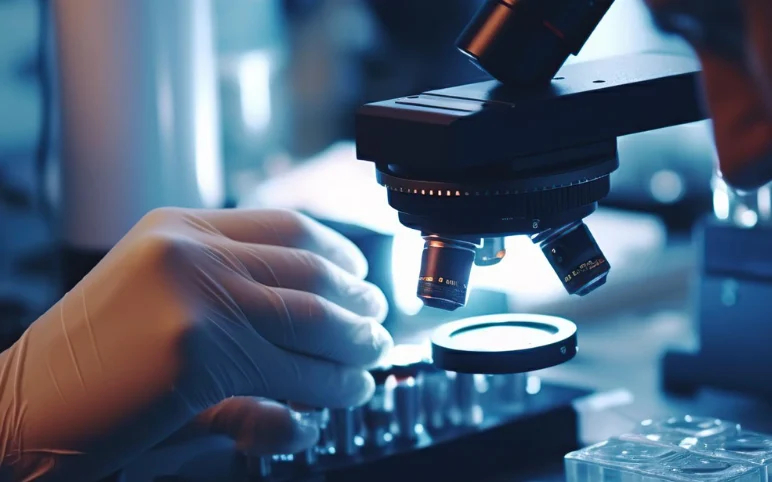Scanogen Received FDA Breakthrough Device Designation for Rapid Bloodstream Infection Assay
On October 15, 2025, Scanogen Inc., a molecular diagnostics innovator developing next-generation infectious disease detection technologies, announced that the U.S. Food and Drug Administration (FDA) granted Breakthrough Device Designation for its rapid assay that identifies bloodstream infection pathogens directly from patient samples.
The FDA’s Breakthrough Device designation is reserved for technologies with the potential to significantly improve the diagnosis or treatment of life-threatening or permanently debilitating conditions. This recognition will accelerate the development and regulatory review of Scanogen’s assay an important advancement in the fight against sepsis, a condition impacting more than 1.7 million Americans annually and responsible for over 350,000 deaths.
Scanogen’s lead product is powered by its proprietary SMART (Single Molecule and Rapid Tethering) technology platform, which enables rapid, precise, and cost-efficient infectious disease detection. Its flagship assay focuses on bloodstream infections in sepsis patients, providing species-level identification in just two hours, far faster than the one to five days required by conventional blood culture methods.
By facilitating timely, targeted antimicrobial therapy, this diagnostic test is expected to improve patient survival rates, reduce unnecessary use of broad-spectrum antibiotics, and lower hospital expenditures. With sepsis care costs exceeding $50 billion each year in the U.S., Scanogen’s breakthrough technology has the potential to deliver significant healthcare savings and redefine infection management standards.
“This FDA recognition underscores the clinical need for faster, more accurate sepsis diagnostics and validates the potential impact of our platform,” said Dr. Al Celedon, Founder and CEO of Scanogen. “Our goal is to empower clinicians with actionable results in hours rather than days—because every hour counts when treating sepsis.”
As per DelveInsight’s “Infectious Disease Diagnostics Market Report,” The infectious disease diagnostics market was valued at USD 38.52 billion in 2023 and is estimated to grow at a CAGR of 3.80% during the forecast period from 2024 to 2030 to reach USD 48.10 billion by 2030. The infectious disease diagnostics market is experiencing significant growth due to the increasing cases of infectious diseases including HIV, hepatitis B & C, and influenza, the introduction of new and innovative products by key players, and others that are acting as significant factors contributing to the overall growth of the infectious disease diagnostics market during the forecast period from 2024 to 2030.
Lapsi Health Unveiled Keikku 2.0: World’s First FDA-Cleared Digital Stethoscope with Integrated AI Scribe
On October 15, 2025, Lapsi Health, a fast-growing health technology innovator with operations across Europe and the U.S., announced the launch of Keikku 2.0, a groundbreaking medical device designed for clinicians. Keikku 2.0 is the first FDA-cleared digital stethoscope that not only listens but also transcribes and assists in diagnostics through real-time AI integration.
“Keikku 2.0 is the first multimodal device to combine clinical, administrative, and AI power in one tool,” said Jhonatan Bringas Dimitriades, MD, CEO and co-founder of Lapsi Health. “For the first time, physicians can listen, document, and diagnose in real time with a single device. That means less time on paperwork and more focus on patients. We’re proud to bring this innovation to market and give clinicians back hours each day to deliver better patient care.”
Keikku 2.0 is a Class II medical device designed to streamline clinical workflows and enhance diagnostic precision. It automatically generates ready-to-use clinical notes compatible with all major EHR systems and scribe technologies, reducing the documentation time that primary care physicians typically spend on electronic records. Beyond documentation, Keikku 2.0 leverages AI-driven auscultation analytics and multiple sensors to detect cardiac murmurs and lung abnormalities in real time, transforming sound into structured clinical data for more accurate, personalized care. Its high-definition ambient microphones capture clinical-grade sound even in noisy environments while ensuring patient data security through HIPAA-compliant encryption. Compact, lightweight, and wireless, the device pairs with smartphones and is suitable for use during hospital rounds, outpatient visits, or field-based care, with future iterations expected to offer standalone functionality, making it a versatile tool designed by physicians for everyday clinical use.
“As physicians, we designed Keikku 2.0 to fit seamlessly into clinical workflows. Every feature was built to improve efficiency and reduce stress for healthcare providers,” said Diana van Stijn, MD, PhD, Chief Medical Officer and co-founder at Lapsi Health. “We set out to create a tool that feels familiar like a smart medical assistant to reduce burden and free clinicians to focus their energy on patient care.”
“Just as Apple reimagined the phone, Keikku redefines listening to voice and the human body. It’s not just a tool, it’s a Medical Assistant,” said Shafi Ahmed, MD, PhD, Professor and General Surgeon, London, England.
“A powerful tool to carry unlimited AI into my clinical practice, so I can use it responsibly,” said Carlos Sendon, MD, Pulmonologist, Washington, DC.
As per DelveInsight’s “Stethoscope Market Report,” The global stethoscope market is estimated to grow at a CAGR of 5.3% during the forecast period from 2024 to 2030. The demand for stethoscopes is primarily driven by the increasing number of patient visits to physicians, largely due to the rising prevalence of chronic diseases, including cardiovascular diseases, respiratory illnesses such as asthma and bronchitis, and lifestyle disorders like hypertension, diabetes, and obesity. Further, the increasing geriatric population, the rising demand for an electronic stethoscope, various product approvals & launches, innovation in product development, and others are contributing to the overall growth of the stethoscope market during the forecast period from 2024 to 2030.
Medtronic BrainSense™ Adaptive Deep Brain Stimulation named a 2025 TIME Best Inventions
On October 9, 2025, Medtronic, a global leader in healthcare technology, announced that its BrainSense™ Adaptive Deep Brain Stimulation (aDBS), the world’s first closed-loop DBS system for individuals with Parkinson’s disease, had been featured on TIME’s annual list of Best Inventions.
Globally, more than 10 million people live with Parkinson’s disease. While there is no known cure, Medtronic’s deep brain stimulation (DBS) technology has been improving the quality of life for people with Parkinson’s and other neurological disorders for over three decades. The company’s latest advancement, the Percept™ DBS neurostimulator with BrainSense™ Adaptive technology, offers a personalized approach to therapy by continuously sensing and responding to a patient’s brain activity in real time, reducing the need for manual stimulation adjustments.
For over 20 years, TIME has highlighted the most influential innovations shaping the future, spanning categories such as artificial intelligence, healthcare, accessibility, and sustainability. Each invention is evaluated for its impact, ingenuity, and success, and Medtronic’s inclusion underscores its leadership in advancing brain-computer interface (BCI) applications in clinical therapy.
The BrainSense™ technology was developed over two decades to create a fully sensing-enabled DBS system capable of detecting, recording, and classifying brain signals. This achievement positions Medtronic at the forefront of integrating therapeutic BCI technology into clinical neuromodulation. The BrainSense™ aDBS represents the largest commercial deployment of BCI technology to date.
Earlier this year, Medtronic received both CE Mark and U.S. FDA approval for BrainSense™ Adaptive DBS. To date, more than 1,000 patients worldwide have been treated with the adaptive therapy. Clinical results from the pivotal ADAPT-PD study, published in JAMA Neurology, demonstrated the therapy’s long-term safety, clinical effectiveness, and strong patient preference, reinforcing BrainSense™ aDBS as a transformative milestone in personalized neuromodulation for Parkinson’s management.
We’re honored that our BrainSense™ Adaptive DBS technology for people with Parkinson’s is being recognized as one of the year’s most important medical innovations,” said Paolo Di Vincenzo, president of the Neuromodulation business, which is part of the Neuroscience portfolio at Medtronic. “This groundbreaking technology represents intentional innovation that responds to a patient’s changing needs, equips clinicians with unparalleled insights, and sets a new standard for DBS therapy.”
According to DelveInsight’s “Deep Brain Stimulation Devices Market Report,” The deep brain stimulation devices (DBS) Market was valued at USD 1.31 billion in 2023, growing at a CAGR of 10.40% during the forecast period from 2024 to 2030 to reach USD 2.37 billion by 2030. The demand for deep-brain stimulation (DBS) devices is experiencing growth due to the increasing prevalence of neurological disorders, such as Parkinson’s disease and epilepsy. The rising geriatric population, which is more susceptible to these disorders, is a major factor driving this trend. Additionally, the growing focus on research and development (R&D) and technological advancements in product innovation are contributing significantly to the positive growth of the deep brain stimulation devices market during the forecast period from 2024 to 2030. These advancements in DBS technology are aimed at improving the precision, safety, and efficacy of treatments for neurological conditions. As a result, more patients are turning to DBS as a therapeutic option, boosting market expansion.
Photocure and Intelligent Scoped Corporation Partnered on Development of AI for Blue Light Cystoscopy
On October 15, 2025, Photocure, a leader in bladder cancer diagnostics known for its Hexvix®/Cysview® products, entered a development agreement with ISC, a U.S.-based subsidiary of Claritas HealthTech Limited (UK), to advance AI software integrated with blue light cystoscopy (BLC) for improved bladder tumor detection. ISC and its affiliates develop leading endoscopy solutions, which ISC commercializes globally.
The collaboration focuses on creating AI software that supports physicians in real time during blue light cystoscopy, enhancing early-stage bladder cancer diagnosis, detection, and completeness of tumor resection. Initial testing involved approximately 200 blue light procedures and over 80,000 images, demonstrating that AI-enabled BLC can identify high-risk cancerous lesions earlier and with greater accuracy along the patient care pathway.
Photocure will contribute to the development effort through an initial clinical study, collecting blue light videos and images from bladder cancer patients across multiple sites in the U.S. and Europe. This data will be used to train the AI software, advancing the goal of more precise, early detection and improved clinical outcomes in bladder cancer management.
“The integration of AI will ensure BLC continues to out-perform white light cystoscopy, as initial performance data indicate blue light AI has the potential to detect more tumors, especially high-grade flat carcinoma in situ (CIS) lesions, than white light AI. However, assisting urologists in the detection of tumors with AI-enhanced blue light cystoscopy is just a first development step. We also intend to explore the blue light AI software to assist with real-time tumor characterization and mapping of CIS lesions for enhancing risk stratification and precision monitoring. Such additional aims expand the utility of our technology to further help urologists achieve their bladder cancer management goals with BLC. These next iterations could drive practice-changing applications that blue light cystoscopy can uniquely deliver,” said Anders Neijber, Chief Medical Officer of Photocure
Dr. Rajesh Nair, Urological Surgeon at Guy’s and St. Thomas’, UK, and Chief Medical Officer at ISC, commented, “As a practicing bladder cancer surgeon, where I regularly face the challenge of accurate detection and complete resection of tumors, I am excited about the prospect of a new solution that combines ISC’s proven track record in state-of-the-art AI solutions for cystoscopy with the detection capabilities of blue light cystoscopy that Photocure provides. With the evidenced improvement in accuracy achieved with ISC’s existing AI technology for bladder tumor detection, the application of its cutting-edge technology together with the enhanced detection capability of blue light cystoscopy from Photocure marks a significant leap forward in bladder cancer diagnostics with the potential to transform bladder cancer management, significantly enhancing patient care and outcomes.”
According to DelveInsight’s “Bladder Scanners Market Report,” the bladder scanners market is estimated to grow at a CAGR of 6.12% during the forecast period from 2025 to 2032. The demand for bladder scanners is driven by the growing prevalence of urinary disorders such as urinary retention, incontinence, and overactive bladder, particularly due to the aging global population, which is more prone to developing such conditions. Additionally, the rising demand for non-invasive diagnostic solutions is boosting market growth. Bladder scanners offer a quick and accurate alternative to traditional methods like catheterization, making them increasingly popular in clinical and home care settings. Ongoing R&D activities and product launches by key players are also contributing to the market expansion. As a result, the bladder scanner market is expected to grow steadily during the forecast period from 2025 to 2032.
Conformal Medical Announced First Patient Enrollment in the E.U. for CONFORM Pivotal Trial with The CLAAS® AcuFORM™ LAAO Device
On October 14, 2025, Conformal Medical, Inc., a medical device company advancing next-generation solutions for left atrial appendage occlusion (LAAO), has announced the start of patient enrollment in the European Union for its CONFORM Pivotal Trial. The first EU procedure was successfully performed at Institut Cardiovasculaire Paris Sud (ICPS) in France by Philippe Garot, MD, FESC, Head of Interventional Cardiology.
The trial is evaluating the CLAAS® AcuFORM™ LAAO device, an innovative foam-based implant designed to simplify LAAO procedures while conforming to individual patient anatomy. The device aims to provide an effective solution for stroke prevention in patients with non-valvular atrial fibrillation (AFib).
“The CLAAS AcuFORM system represents an important innovation in LAAO, with the potential to simplify procedures, expand access, and improve outcomes for patients with non-valvular AFib,” said Dr. Garot. “We are excited to participate in the CONFORM Pivotal Trial and to help bring this next-generation therapy to patients across Europe.”
The extension of the CONFORM trial into the EU represents a major milestone for Conformal Medical, highlighting the study’s scalability and the global potential of the CLAAS® AcuFORM™ system. By leveraging Europe’s diverse healthcare infrastructure and established clinical networks, this phase of the trial aims to generate robust real-world evidence, accelerate physician adoption, and establish a solid foundation for future commercialization.
“Partnerships with leading European centers strengthen our global presence, accelerate innovation, and position us to deliver the benefits of our differentiated technology to patients worldwide,” said James Reinstein, President and CEO of Conformal Medical. “We believe the CLAAS AcuFORM system will be a competitive offering, with its ability to conform to individual anatomies, simplify procedures with just two device sizes, and provide reliable seal confirmation.”
About the CONFORM Pivotal Trial
The CONFORM Pivotal Trial is a prospective, multicenter, randomized controlled study designed to evaluate the safety and efficacy of the Conformal CLAAS® AcuFORM™ System versus other commercially available left atrial appendage (LAA) devices. The trial plans to randomize approximately 1,600 patients across global sites and is currently over 30% enrolled. Its goal is to generate pivotal clinical data supporting next-generation stroke prevention therapies for patients with non-valvular atrial fibrillation (AFib) seeking alternatives to long-term oral anticoagulation.
According to DelveInsight’s “Left Atrial Appendage Closure Devices Market Report,” the left atrial appendage closure device market Was Valued at USD 1,206.94 million. In 2023, growing at a CAGR of 11.45% during the forecast period from 2024 to 2030, to reach USD 2,564.70 million by 2030. The rising prevalence of cardiovascular disorders such as atrial fibrillation, ischemic strokes, and heart attacks is primarily bolstering the demand for left atrial appendage closure devices. Additionally, increasing technological advancements in the domain of left atrial appendage closure are another key factor contributing to the growth of the left atrial appendage closure market during the forecast period from 2024 to 2030.
Materna Medical announced Oral Presentation Comparing Outcomes of Dilator-Experienced vs. Naïve Patients from an At-Home Study
On October 10, 2025, Materna Medical announced that an interim sub-analysis from the Prospective On Market Patient-reported Outcomes for Milli (POMPOM) clinical study will be presented orally at the Sexual Medicine Society of North America (SMSNA) Annual Meeting. The analysis highlights a significant difference in effectiveness between the two user groups.
The abstract, titled “POMPOM 3-Month Comparative Analysis of Static Dilator-Experienced vs. Naive Participants Using the Milli Expanding Vaginal Dilator,” examines outcomes in women with prior static dilator experience compared to those new to dilation therapy, using the Milli Expanding Vaginal Dilator as an at-home solution.
When experienced dilator users were asked why they purchased Milli, one POMPOM participant said, “[I] want to have more intermediate options than my static dilators, and [I] also want the vibration option.”
When asked about the impact of Milli on her sex life, one POMPOM participant remarked, “Wonderful to have a gradual diameter change rather than a bunch of individual dilators that all need to be stored and cleaned.” This interim comparative analysis represents an important advancement in sexual medicine, confirming the effectiveness of an expanding vaginal dilator and providing clinicians with valuable guidance for managing patients with diverse treatment histories. Both naive and experienced users demonstrated statistically significant improvements from baseline in pain during intercourse, sexual function (FSFI), and anxiety. Notably, naive participants experienced a greater reduction in pain during intercourse on the visual analog scale (VAS)—27.8% (p<0.0001) compared to 22.5% (p=0.0028) for experienced users and a larger reduction in VAS anxiety: 24.2% (p=0.0021) versus 15.8% (p=0.0291) for experienced users. At six months, 81.8% of naive participants and 65.0% of experienced participants who attempted intercourse reported successful sexual activity.
Overall, the findings underscore Milli’s potential to improve sexual function, reduce treatment barriers, and offer an evidence-based solution for patients new to vaginal dilation therapy.
“It’s an honor to be selected for an oral presentation at SMSNA, which highlights the scientific rigor and clinical importance of this specific sub-analysis,” said Dr. Sheryl Kingsberg, Chief of Behavioral Medicine in the Department of Ob/Gyn at University Hospitals Cleveland Medical Center and principal investigator in the POMPOM study. “The ability to demonstrate positive outcomes in dilator-naïve and dilator-experienced patients is a powerful finding that validates this therapy as a viable option for a broad range of individuals. This data can inform clinical practice and offer hope to patients who are new to or have exhausted previous therapy options.”
According to DelveInsight’s “Dilators Market Report”, the global dilators market is expected to grow at a CAGR of 8.20% during the forecast period from 2024 to 2030. The dilators market is witnessing a positive market growth owing to the growing surgical demand in various fields, majorly gastrointestinal, gynecological conditions in geriatric women, nasal conditions, and many others, significant advancements in product development, and rapid evolution of advanced dilators, thereby contributing to the growth of the Dilators market during the forecast period from 2024 to 2030.



